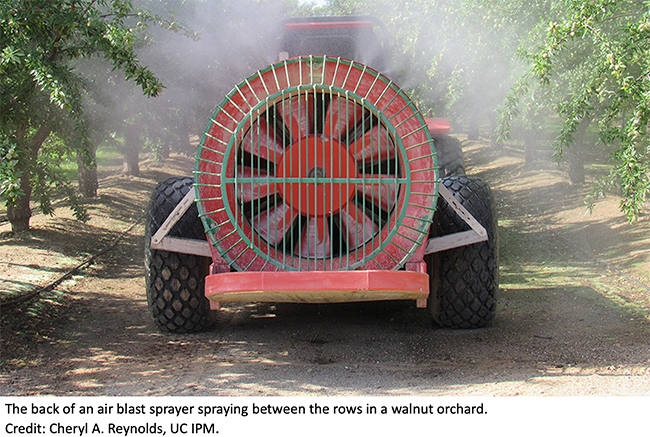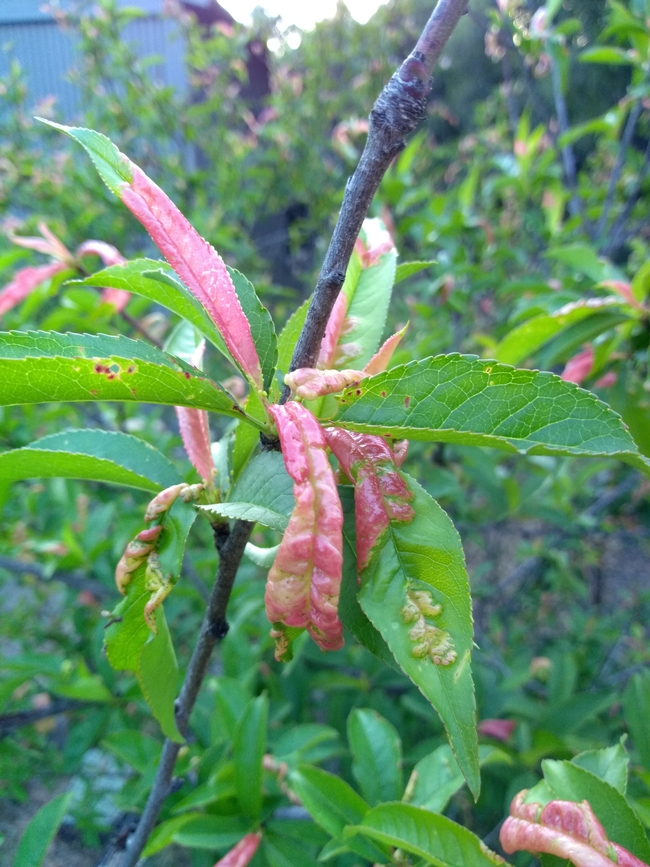Author: Petr Kosina, UC Statewide IPM Program
To raise awareness of pesticide safety practices, February is celebrated as National Safety Education Month. This year the University of California Statewide Integrated Pest Management Program offers help to refresh your knowledge about safe and effective pesticide use. Two frequently sought-after online courses focused on proper pesticide use to avoid illegal residues and proper selection, use, and removal of personal protective equipment are offered for free during the month of February. Use code safety100 at checkout to get your continuing education units (CEU) for free.
Pesticides are among the most regulated chemicals in the country. In the United States, the Environmental Protection Agency (EPA) regulates the use of pesticides. All pesticides must be registered with the EPA, and the agency requires a battery of scientific tests to determine the potential risk to humans and the environment. 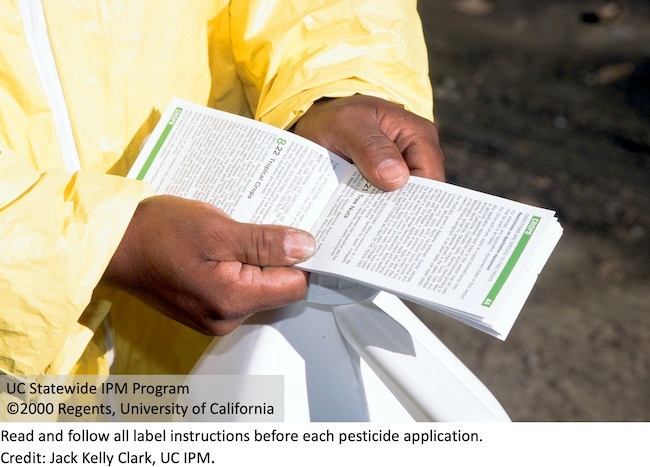
Best practices for using pesticides safely start with reading the label before each pesticide application. How will readingthe label help you? Pesticide labels answer most of the basic questions you need to know about the product, its safe application and handling. Always make applications in strict accordance with all label instructions. Following label instructions will ensure safe, effective, and cost-effective use of the pesticide. Apart from the label, it is important to know what your state regulations are because some state regulations that also have to be observed are not written into the label. Note that not all pesticides approved by the EPA and available for purchase in the United States can be used in California. California is one of the few states that have more strict pesticide regulations for certain pesticides than what is required by the EPA. Even if you have used a given pesticide in the past, make sure you have an up-to-date label, as EPA may occasionally change labels. To learn more about pesticide labels and how to extract information relevant to the specific setting and situation in order to apply pesticides safely, enroll in the online course Proper Pesticide Use to Avoid Illegal Residues. Pest management professionals will earn 2.0 hours of Laws & Regs CEUs.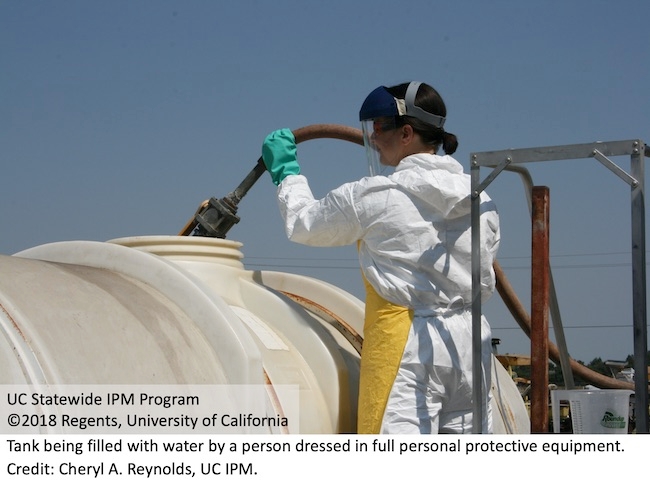
Because pesticides have the potential to cause injury or illness to anyone working with them, it is important to wear personal protective equipment, or PPE, to reduce a person's exposure to pesticides. PPE includes clothing and certain devices worn to protect the human body from contact with pesticides or pesticide residues. Regular clothing is not considered PPE even though some pesticide labels may indicate that these specific items of regular work clothes can be worn during certain activities. All employees who handle pesticides in California are legally required to wear PPE. They must follow all PPE instructions on the pesticide label and follow all California laws and regulations. To learn how to select the proper PPE, use it, remove it, and dispose of it or clean and store it before, during, and after each incidence of pesticide handling and application, enroll in the online course Proper Selection, Use, and Removal of Personal Protective Equipment (PPE). Pest management professionals will earn 1.5 hours of Laws & Regs CEUs.
Visit the UC IPM website to see all 22 online courses that are available for continuing education credit.
Written by-- Petr Kosina, UC Statewide IPM Program
A brand-new online course on Diagnosing Herbicide Injury focusing on how an herbicide injury situation can arise, what information can help diagnose symptoms during field investigations, and what tools are available to you, is now available from the UC Statewide Integrated Pest Management program (UC IPM).
When unexplained damage is noticed on a crop or other non-weed plant, herbicides are often a primary suspect. That is no surprise because herbicides are very powerful and effective tools used to control weedy plants in a wide variety of locations. However, symptoms of many other plant stresses, such as diseases and nutrient deficiencies or toxicities, can closely resemble the injury symptoms caused by herbicides. Economic implications of herbicide damage can vary–in some cases visible injury may have very little direct economic effect while in others, even slight herbicide symptoms can affect the marketability of affected plants. In addition, the presence of an unregistered herbicide on non-target crops can result in illegal residues which could have both safety and legal consequences.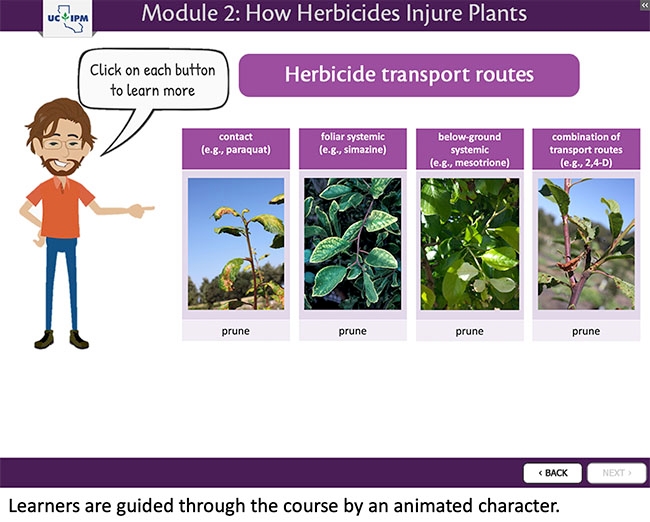
The new online course was developed by Dr. Brad Hanson and Dr. Kassim Al-Khatib from the Department of Plant Sciences at UC Davis, and UC IPM instructional designers. If you are a grower, pest control adviser, or pesticide applicator, then this course is a great opportunity to learn about how to approach crop injury investigation when herbicide is suspected cause. You will learn how herbicides injure plants, how long herbicide symptoms may last and factors that may influence the time that herbicide injury symptoms are visible, possible scenarios of herbicide exposure based on uniform and variable injury patterns observed in the field, how to prepare samples for the laboratory analysis and more.
The course content is free to anyone who wishes to view it. For those requiring a certificate of completion and continuing education units (CEUs), the regular cost is $30, but we are offering a reduced price of $15 through October 31, 2021. Diagnosing Herbicide Injury course has been approved by the California Department of Pesticide Regulation (DPR) for 1.5 continuing education units (CEU) of Other, Certified Crop Advisor (CCA) for 1.5 units (IPM), and the Arizona Department of Agriculture for 1.0 Credit.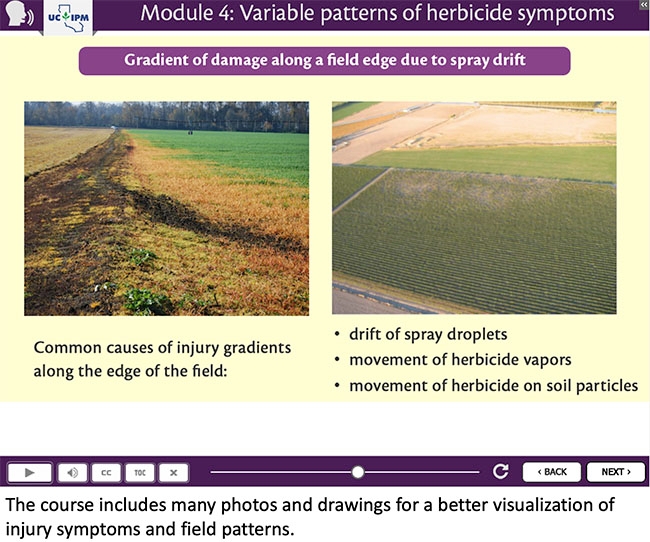
If you are a DPR license or certificate holder with a last name beginning with letters M through Z, then this will be your year to renew. Now is a good time to check out the other UC IPM online training courses offered. All are 50% off the regular price through October 31st. DPR strongly suggests returning renewal packets back to them by October so that your license or certificate can be renewed before it expires. Many of our courses are accredited by DPR for continuing education hours and also by the California Structural Pest Control Board (SPCB), Certified Crop Advisor (CCA), the Western Chapter of the International Society of Arboriculture (WCISA), and the Arizona Department of Agriculture.
- Author: Rose Marie Hayden-Smith
Invasive shot hole borers (ISHB) are tiny beetles that are posing a significant threat in Ventura County and beyond.
There's new information provided in a recent blog post that appeared on website of the Channel Islands Chapter of the Community Association Institute in January 2021. Wayne Farnsworth of
These pests are becoming established in parts of Ventura County. Farnsworth and Oliver note that "Unlike many insect pests, invasive shot hole borers infest a wide variety of tree species, including many common ornamentals, avocados and California natives. Sycamores and box elders are among their favorites, and they also attack live oaks, valley oaks and alders, all of which are abundant in our area."
Per UC ANR, invasive shot hole borers are
"two closely related species of small, non-native, beetles that bore into trees. ISHB introduce fungi that cause a tree disease called Fusarium dieback (FD). The ISHB-FD pest-disease complex is responsible for the death of thousands of trees in Southern California and poses an imminent threat to the integrity of our urban and natural forests.
Invasive shot hole borers attack a wide variety of tree species including avocados, common landscape selections, and California native species in urban and wildland environments."
You can learn more about ISHB at the UC ANR Integrated Pest Management website.
As Julie Di Blasio reported last year, "...invasive shot hole borer (ISHB) infestations have been identified in Ventura County since 2015 but have not significantly spread. Discovery of the pest/disease complex was found in late 2018 in the urban forest of Meiners Oaks. Citizens Journal recently published an article about the removal of a tree that was at risk for amplifying the local infestation and causing potential other community harm."
UCCE Ventura has been collaborating to address ISHB with UC insect, disease, education specialists, Ventura County Agricultural Commissioner, CAL FIRE, US Forest Service, several other agencies and non-government organizations. We are locally active in monitoring and outreach. Ventura County Master Gardeners Invasive Pests Outreach Group augments our work through their efforts to educate the public, firewood users and vendors."
Image credit: Akif Eskalen, UC Davis/UC ANR
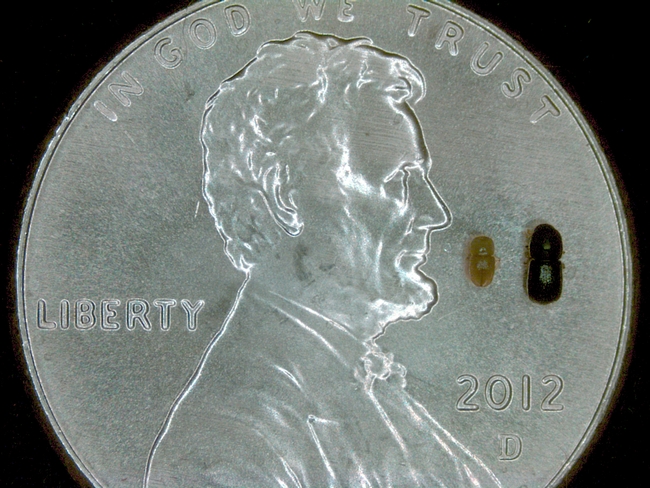
- Author: Cheryl Reynolds
We're excited to announce that a brand-new online course on air blast spray calibration is now available. This course was developed by Lynn Wunderlich, University of California Cooperative Extension (UCCE) farm advisor for the Central Sierra, and Franz Niederholzer, UCCE farm advisor for Colusa, Sutter, and Yuba counties.
If you are a grower, pest control adviser, or pesticide applicator working in trees and vines, then this course is for you! You will learn the basic principles of spray calibration, take a close look at the basic components of a sprayer, perform calculations needed for calibration, and take a look at how factors such as droplet size, nozzle type, and weather conditions influence drift and spray coverage. This course also explains the conditions for pesticide applications under the 2018 Pesticide Use Near Schoolsites regulation. Air Blast Spray Calibration has been approved by DPR for a total of 2.5 continuing education units (CEUs), including 0.5 hour of Pesticide Laws and Regulations and 2.0 hours of Other.
Fall is here and 2020 is winding down; it's time to complete your continuing education units and submit your California Department of Pesticide Regulation (DPR) renewal packet. If you are a DPR license or certificate holder and your last name begins with the letters A through L, then 2020 is your year to renew. Renewing now guarantees a quick turnaround time and having enough time to resolve any problems before your license expires. DPR encourages all license holders to send in renewals November 1 to ensure license renewal by January 1, 2021. Why not check out the online courses the UC Statewide IPM Program (UC IPM) has to offer?
Four of UC IPM's most-wanted courses are offered at an early-bird price until November 1st! You can save an additional $20 by purchasing the 4-course bundle for only $85 rather than each course individually.
- Proper Pesticide Use to Avoid Illegal Residues (2 hours Laws and Regulations – early-bird price $40; full price $80)
- Proper Selection, Use, and Removal of Personal Protective Equipment (1.5 hours Laws and Regulations – early-bird price $30; full price $60)
- Pesticide Resistance (2 hours Other – early-bird price $20; full price $40)
- Pesticide Application Equipment and Calibration (1.5 hours Other – early-bird price $15; full price $30)
Many of our courses are now credited not only by DPR for continuing education hours, and also by the California Structural Pest Control Board (SPCB), Certified Crop Advisor (CCA), the Western Chapter of the International Society of Arboriculture (WCISA), and the Arizona Department of Agriculture.
- Author: Annemiek Schilder
In this weekly blog, Dr. Annemiek Schilder, Director, UCCE Ventura County and Hansen Agricultural Research and Extension Center, shares her observations about the natural world across the seasons. As she says:
"Gently observing your surroundings with curiosity will teach you some amazing things. There are so many fascinating things happening under our noses, only wanting for an observant eye."
"What is wrong with my peach tree?"
Many people have probably asked this question as they have stared in concerned wonder at the distorted leaves of their peach trees. From a distance the striking color patterns may even look like peculiar flowers. Peach leaf curl is a disease of peach and nectarine trees caused by the fungus Taphrina deformans, an apt name for this fungus. Ornamental peach trees, grown for their beautiful blooms, are also susceptible to this disease.
Peach leaf curl is a common plant disease featured in many plant pathology textbooks. It may well have been the disease that convinced me to become a plant pathologist (a plant doctor) as I peered with increasing fascination at its structures under the microscope.
Allow me to digress a little to discuss that great invention: the microscope. In the late 1600's, Antonie van Leeuwenhoek, a self-taught Dutch scientist, developed a single lens microscope with up to 300 times magnification, allowing observation of bacteria for the first time. He called them “little animals”. However, it would take another 200 years before bacteria and fungi were officially recognized as causes of disease in animals and plants, laying the groundwork for modern-day medicine.
The name of this disease, peach leaf curl, is quite descriptive as the fungus causes leaves to curl and develop blister-like areas. Rainy, cool springs promote infection - as well as spore production - on infected leaves. Spores are spread by wind and rainsplash to other leaves, where they can cause new infections. The disease is not only unsightly –except to the eyes of a plant pathologist, of course - but also causes diseased leaves to drop prematurely, which weakens the tree and may lower fruit yield. In severe cases, repeated defoliations can kill a tree.
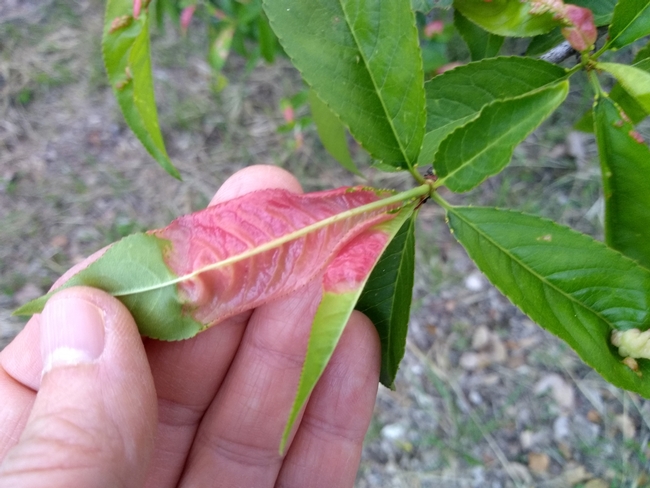
Taphrina deformans spores are produced in elongated structures called asci, a Latin word meaning “sacs”.
Have you noticed that Latin is used a lot for botanical descriptions? This is because Latin is a “dead” language and thus grammatically stable.
Taphrina's asci are lined up in layers on the leaf surface without any protective covering; therefore they are termed “naked asci”. So guess what name my Plant Pathology student volleyball team chose? Indeed, our t-shirts sported botanically correct drawings of Taphrina's asci, causing the other teams to think of us a bunch of weird science nerds. Nerds who played a pretty good game of volleyball mind you!
So what can you do to keep your trees healthy? Here are a few tips.
- If you are thinking of planting a peach or nectarine tree, investigate whether resistant varieties are available so you can avoid the problem altogether.
- For established trees, fall pruning of diseased shoots may help.
- Also for established trees, (organic) copper fungicide sprays in late fall after leaf drop and before budbreak in the spring may help.
- Addition of a horticultural oil may improve spray coverage. Be sure to follow the instructions on the label carefully.
If your tree got whacked by the disease, infected leaves will fall off and new leaves will develop but this requires the tree to expend additional energy. A foliar fertilizer application as well as fruit thinning can help the tree recover.
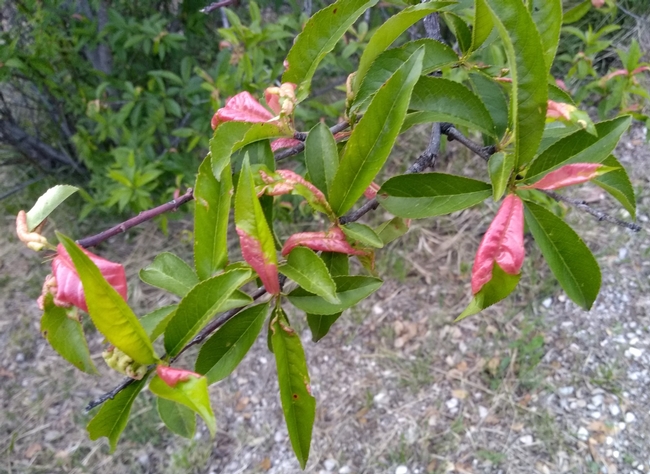
Related Reading:


